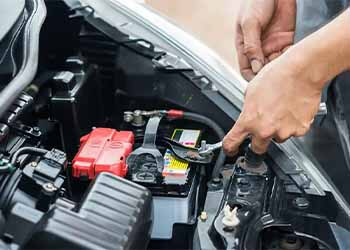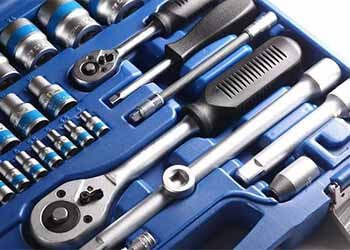Last Updated on April 6, 2023 by TechChecking
A car battery is an essential component of any vehicle, providing the necessary power to start the engine and operate various electrical systems. While it is critical to ensure that your car battery is functioning correctly, you may encounter situations where you need to remove or replace the battery. To do so, you will need to use the appropriate tools, including a wrench. So, what size wrench for a car battery? Well, it can be challenging to know what size wrench to use, as this can vary depending on the make and model of your car. In this guide, we will discuss the factors that determine the size of wrench needed for a car battery, as well as some general guidelines to help you make the right choice.
Contents
- What is a Car Battery Wrench?
- What Size Wrench for a Car Battery?
- Types of Wrenches for Car Batteries
- How to Choose the Right Size Wrench for a car battery?
- How to Change a Car Battery?
- Frequently Asked Questions
- What size wrench do I need for my car battery?
- What are the different types of car batteries?
- How do I determine the correct battery size for my car?
- What are the different types of wrenches for car batteries?
- How do I choose the right size wrench for my car battery?
- How do I remove and replace a car battery?
- What are some tips for maintaining my car battery?
- What are the signs of a failing battery?
- How do I jump-start a car with a dead battery?
- How often should I replace my car battery?
- Final Words
What is a Car Battery Wrench?

A car battery wrench is a tool used to tighten or loosen the nuts or bolts that connect the battery cables to the battery terminals. It is specifically designed to fit the size and shape of the battery terminals, making it easier to work in tight spaces and avoid damaging the terminals. Car battery wrenches come in different sizes and types, including open-end, box-end, adjustable, and combination wrenches, to accommodate different sizes of battery terminals and provide versatility for different types of vehicles. Having a car battery wrench on hand is essential for any car owner or mechanic who needs to replace or work on a car battery.
Read More Articles:
- How to Measure Socket Drive Size
- Best 21 Different Types of Wrenches and Their Uses
- Best Adjustable Wrenches for Daily and Professional Tasks
- Different Types of Socket Wrenches
- Socket Wrench vs Ratchet
What Size Wrench for a Car Battery?
The size of wrench needed for a car battery varies depending on the size of the battery terminals. The most common sizes for battery terminals are 10mm and 13mm, so it’s recommended to have both sizes of wrenches on hand to ensure that you have the correct one. In addition, adjustable wrenches can also be used to accommodate different sizes of terminals. It’s important to use the correct size wrench to avoid damaging the terminals and to ensure a secure and safe connection.
What Is The Battery Terminal Wrench Size?
The most common size for a battery terminal wrench is 10mm. However, some car batteries may require a different size, such as 8mm or 13mm. It’s important to consult your vehicle’s owner manual or the battery manufacturer’s specifications to determine the correct size wrench for your battery. Using the wrong size wrench can damage the battery terminals and cables, and potentially create a safety hazard. It’s also recommended to use a wrench with a rubber or plastic coating to prevent accidental electrical shocks.
Types of Wrenches for Car Batteries
When it comes to changing a car battery, there are a few different types of wrenches available that can make the job easier or more efficient.
- Open-end wrench: This type of wrench has a U-shaped opening on one or both ends, allowing it to fit over the bolt from the side. While it is easier to maneuver, it only grips two sides of the bolt and can slip more easily.
- Box-end wrench: This type of wrench has a closed end that fully encloses the bolt head, providing a more secure grip and minimizing the risk of slipping. However, it may be more difficult to maneuver due to its closed end.
- Adjustable wrench: As the name suggests, this type of wrench has an adjustable jaw, allowing it to fit a variety of bolt sizes. While it is versatile, it may not provide as secure of a grip as a fixed-size wrench.
- Combination wrench: This type of wrench combines an open-end and a box-end wrench in one tool, providing the versatility of an open-end wrench and the security of a box-end wrench. It is often used for hard-to-reach areas and for jobs that require both types of wrenches.
How to Choose the Right Size Wrench for a car battery?
Choosing the right size wrench for your car battery is critical to maintaining a reliable and secure connection.
To select the right size, you need to determine the diameter of the battery terminal, which can be found in the owner’s manual or by measuring with a caliper. Once you have the terminal size, choose a wrench that fits over the terminal snugly without slipping or wobbling. This ensures that the wrench won’t damage the terminal or cables due to excess force or slipping.
Additionally, you may want to consider the type of wrench that is best for your needs, such as an open-end, box-end, adjustable, or combination wrench. By taking the time to select the right size and type of wrench, you’ll make the job of working on your car battery easier, faster, and more efficient.
What Other Tools Besides Wrenches Are Needed To Replace A Car Battery?

Replacing a car battery requires more than just a wrench, though the exact tools you need will depend on your specific vehicle and battery. Here are some common tools that you may need in addition to a wrench:
- Safety equipment such as gloves and goggles to protect your hands and eyes from acid spills and battery corrosion.
- A battery terminal cleaner to remove any buildup on the battery posts and terminals.
- A battery brush to scrub away any remaining corrosion or buildup.
- A battery charger to test the battery and ensure it is fully charged before installing it.
- A ratchet and socket set to remove any bolts or brackets holding the battery in place.
- A battery hold-down or strap to secure the battery in its new position.
- A voltage tester to check the battery’s charge level and make sure it is operating correctly after installation.
These tools are important while changing the car battery. We focus on the wrenches because they play the main role. Anyways, when you are performing the job, just make sure you have the right tools and follow the correct procedures for replacing your car battery safely and effectively.
You can find these different types of wrenches at a reasonable price from Amazon.
How to Change a Car Battery?

Changing a car battery may seem intimidating, but it is actually a fairly simple process that can be done with just a few basic tools. It is an essential skill for any car owner to have, as a dead battery can leave you stranded and unable to start your car. By following a few simple steps, you can replace your car battery and ensure that your vehicle is always ready to go when you need it. In this section, we will provide a step-by-step guide on how to change a car battery.
- Prepare your work area: Ensure the engine is off, put the car in park or neutral, and engage the emergency brake. Wear safety equipment, including gloves and goggles, to protect against acid spills and battery corrosion.
- Locate the battery: Consult your car owner’s manual to locate the battery, which is typically found in the engine compartment, but could also be under the back seat or in the trunk.
- Disconnect the negative cable: Using a wrench or pliers, loosen the nut on the negative cable (marked with a minus sign) and pull the cable off the terminal. This is done first to avoid shorting out the electrical system.
- Disconnect the positive cable: Repeat the process for the positive cable (marked with a plus sign) and pull the cable off the terminal.
- Remove the battery: Use a socket wrench or pliers to remove any bolts or brackets holding the battery in place, then carefully lift the battery out of the compartment.
- Clean the battery tray: Use a wire brush or battery terminal cleaner to clean any corrosion or debris off the battery tray, as well as the terminals.
- Install the new battery: Carefully lower the new battery into the tray and secure it with any bolts or brackets you removed in step 5.
- Reconnect the positive cable: Slide the positive cable onto the positive terminal and tighten the nut securely.
- Reconnect the negative cable: Slide the negative cable onto the negative terminal and tighten the nut securely.
- Test the battery: Turn on the car to ensure that the battery is functioning correctly. If the car does not start or there is an issue, recheck the connections.
By following these steps, you can replace a car battery safely and effectively. However, it’s essential to consult your car owner’s manual or seek advice from a professional mechanic before attempting to replace a battery, as the specific procedures and tools required may vary depending on your car’s make and model.
Tips for Using a Car Battery Wrench
While using a car battery wrench you can use some tricks and techniques. Those tips can help your job done easy and perfect. Well, here are some tips for using a car battery wrench:
- Make sure the wrench is the correct size for the battery terminal before using it. Using the wrong size wrench can damage the terminal.
- Use the appropriate type of wrench for the job. For example, if the battery terminal is in a tight space, an adjustable wrench or a box-end wrench might be a better choice than an open-end wrench.
- Always wear protective gloves and eyewear when working with a car battery to avoid contact with battery acid and other harmful substances.
- Position yourself in a well-lit area when using a car battery wrench. This will help you see what you are doing and avoid mistakes.
- Never force the wrench when tightening or loosening the battery terminal. Over-tightening or under-tightening can cause damage to the terminal or the battery itself.
- Use a torque wrench to ensure that the terminal is tightened to the manufacturer’s recommended torque specification. This will help prevent damage to the terminal and ensure a secure connection.
Though these are simple and basic tips but if anyone ignores it, it could be a great mistake. Following these tips can accelerate the speed of the work.
Is It Dangerous to Replace Car Batteries?
Replacing a car battery can be dangerous if proper precautions are not taken. Car batteries contain sulfuric acid and can produce explosive gases, which can cause severe burns or even an explosion. Therefore, it’s important to wear protective clothing and goggles, and work in a well-ventilated area when replacing a car battery. In addition, it’s important to disconnect the negative cable first, followed by the positive cable, to prevent electrical shock and potential short circuits. Also, care should be taken to avoid touching the metal tools across the battery terminals as it can lead to a spark or explosion. By following safety guidelines and taking the necessary precautions, replacing a car battery can be done safely and effectively.
What Are The Common Habits That Can Potentially Ruin Your Automobile Battery?
There are several common habits that can contribute to the deterioration and failure of your car battery. Here are some of them:
- Leaving headlights or interior lights on for extended periods when the engine is not running
- Failing to drive your car regularly or for long enough distances to fully recharge the battery
- Leaving electronic devices or accessories, such as phone chargers or GPS systems, plugged in when the car is turned off
- Allowing the battery to discharge completely before recharging it
- Exposing the battery to extreme temperatures, especially heat
- Using the wrong type of battery for your car’s electrical system or not replacing the battery when it is due for replacement.
By avoiding these common habits, you can help prolong the life of your car battery and reduce the likelihood of premature failure.
Common Mistakes People Make When Handling Car Batteries
Here are some common mistakes people make when handling car batteries:
- Failing to wear protective gear such as gloves and goggles when handling batteries, which can expose them to harmful chemicals or cause injury from accidental spills or splashes.
- Touching the battery terminals with bare hands or metal tools, which can result in electric shocks or sparks that can cause a fire or damage the battery.
- Not disconnecting the battery properly before attempting to remove it, which can result in short circuits or damage to the vehicle’s electrical system.
- Attempting to charge or jump-start a damaged or worn-out battery, which can result in the battery overheating, leaking or even exploding.
- Ignoring warning signs such as slow cranking or dimming lights, which can indicate a battery problem that needs to be addressed.
- Using the wrong type of battery for the vehicle, which can lead to damage to the electrical system or premature battery failure.
By avoiding these common mistakes and following proper safety procedures, you can ensure that you handle car batteries safely and effectively.
Read More Articles:
- Best Torque Wrenches Made In USA
- SAE vs Metric Sockets
- Socket Sizes in Order [Detailed With Charts]
- 3/8 vs 1/2 Impact Wrench
- Wrench Sizes in Order [Detailed With Charts]
Frequently Asked Questions
What size wrench do I need for my car battery?
The size of wrench you need for your car battery may vary depending on the make and model of your car, but generally a 10mm or 13mm wrench will suffice.
What are the different types of car batteries?
The most common types of car batteries are lead-acid batteries, which can be either flooded or sealed. There are also lithium-ion batteries and nickel-metal hydride batteries, although these are less common in automobiles.
How do I determine the correct battery size for my car?
To determine the correct battery size for your car, you can check the owner’s manual or consult with a professional. You’ll need to know the make, model, and year of your car, as well as any specific requirements for your climate or driving habits.
What are the different types of wrenches for car batteries?
The different types of wrenches for car batteries include open-end wrenches, box-end wrenches, adjustable wrenches, and combination wrenches. Each type has its own advantages and disadvantages.
How do I choose the right size wrench for my car battery?
To choose the right size wrench for your car battery, you can consult the owner’s manual or use a wrench that is adjustable to fit a range of sizes. It’s important to choose a wrench that fits snugly but not too tightly to avoid damaging the battery terminals.
How do I remove and replace a car battery?
To remove and replace a car battery, you’ll need to first disconnect the negative terminal, then the positive terminal. Remove any clamps or brackets holding the battery in place and carefully lift it out. Install the new battery in reverse order, starting with the positive terminal and ending with the negative terminal.
What are some tips for maintaining my car battery?
To maintain your car battery, you should keep it clean and free of corrosion, check the fluid levels regularly, avoid overcharging or undercharging, and replace the battery before it fails completely.
What are the signs of a failing battery?
Signs of a failing battery include slow cranking, dimming headlights, dashboard warning lights, and a battery that is more than 3-4 years old.
How do I jump-start a car with a dead battery?
To jump-start a car with a dead battery, you’ll need a set of jumper cables and another car with a working battery. Connect the cables in the correct order, start the working car, and let it run for a few minutes before attempting to start the dead car.
How often should I replace my car battery?
Car batteries typically last between 3-5 years, although this can vary depending on driving habits and climate. It’s a good idea to have the battery tested regularly and replace it before it fails completely.
Final Words
In conclusion, the size of wrench needed for a car battery varies depending on the specific make and model of the vehicle. It is important to consult the owner’s manual or a trusted mechanic to determine the correct size wrench for your car battery. Using the wrong size wrench can cause damage to the battery or the surrounding components. It is always best to use the correct tools for the job to ensure a safe and successful battery replacement.
Image Credit:

